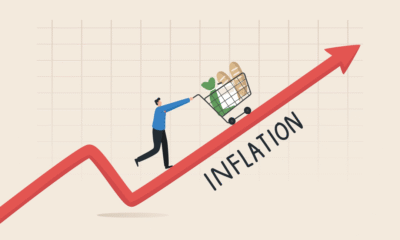Finance
Understanding Section 899 Tax Proposal: Implications for Foreign Investments

Introduction to Section 899
Section 899 of the recent tax proposal has emerged as a pivotal component of the legislative agenda aimed at reshaping the tax landscape concerning foreign investments. Its primary purpose is to address the complexities associated with the taxation of foreign corporations and their income-generating activities within domestic borders. This section falls within a larger framework that seeks to ensure a fair and equitable tax system while fostering an environment conducive to economic growth.
The context for the introduction of Section 899 can be traced back to a growing concern among policymakers regarding the need to adapt tax regulations to the evolving nature of global commerce. As businesses increasingly operate across borders, traditional tax paradigms have struggled to adequately capture the range of foreign investments and their associated benefits or risks. By proposing adjustments under Section 899, legislators aim to mitigate potential tax loopholes and enhance transparency, thus securing a more reliable revenue stream for government expenditures while promoting compliance among international entities.
Furthermore, the implications of Section 899 extend beyond mere tax collection. By refining the existing framework governing foreign investments, this proposal is anticipated to influence investor perceptions and decisions significantly. A clear, balanced tax policy can bolster investor confidence, potentially leading to an influx of foreign capital that can stimulate economic growth and job creation in various sectors. Investors often seek stable and predictable tax environments, and this section of the proposal aims to deliver on that front by establishing guidelines that foster accountability in taxing foreign income.
In summary, Section 899 is not merely a tax proposal but a strategic initiative poised to reshape the interaction between foreign investments and domestic tax obligations. Its successful implementation may yield considerable benefits for the economy, positioning the nation favorably within the global investment landscape.
Key Provisions of the Section 899 Tax Proposal
The Section 899 tax proposal introduces a series of significant changes that aim to reshape the landscape of foreign investments in the United States. One of the major components of this proposal is the establishment of new tax rates specifically targeting foreign investors. These rates are designed to align with the government’s objective of increasing revenue from foreign capital while still encouraging investment. The proposed rates vary depending on the type of income earned, with distinct thresholds that categorize investors based on their earnings. This tiered structure aims to ensure a fair distribution of tax responsibilities depending on the scale and type of investment.
Additionally, the Section 899 tax proposal enforces new compliance requirements for foreign entities. Investors need to furnish detailed information regarding their income sources, which significantly expands the documentation and reporting responsibilities compared to current regulations. These requirements seek to enhance transparency and allow the IRS to effectively track foreign investment flows, thereby reducing instances of tax evasion and ensuring adherence to tax obligations. Failure to comply with these enhanced reporting requirements could lead to substantial penalties, further underscoring the importance of understanding these new provisions.
The proposal also highlights significant differences from existing tax regulations, particularly in how it treats certain types of foreign-sourced income. For instance, while some foreign investments previously enjoyed exemptions or lower tax rates, new stipulations under Section 899 may remove these benefits. It’s crucial for investors to familiarize themselves with these changes to avoid unanticipated tax liabilities. By comprehensively understanding the key provisions contained within Section 899, foreign investors can better navigate the implications of these tax reforms and make informed decisions that align with their investment strategies.
Potential Effects on Foreign Direct Investment (FDI)
The Section 899 tax proposal introduces significant changes that could profoundly influence foreign direct investment (FDI) in the country. Foreign direct investment refers to the investment made by foreign entities in domestic companies or projects, and its movements are sensitive to various factors, including tax policies. As such, it is essential to assess how these proposed tax alterations might alter investor behavior and sentiment. Investors typically evaluate the potential returns on investment alongside the tax burden they would incur.
One immediate implication of the Section 899 tax proposal may be an inclination towards caution among foreign investors. The introduction of new tax structures could lead to an increased financial liability, deterring potential investors who may perceive a less favorable investment environment. Research suggests that tax stability is a crucial factor in attracting FDI. Therefore, given the uncertainty surrounding Section 899, some investors may seek alternative markets that offer more predictable tax regimes.
Historical case studies provide insight into how shifts in tax regulation have impacted FDI flows in the past. For instance, countries that have reduced corporate tax rates or eliminated specific taxes have often witnessed an uptick in foreign investments. Conversely, areas perceived to have high tax burdens, including complex compliance processes, frequently find themselves overlooked by international investors. Thus, the combined effects of the Section 899 tax proposal and the current economic climate could lead to a downturn in FDI if foreign investors decide to prioritize countries with more investor-friendly tax conditions.
In conclusion, the proposed Section 899 tax initiatives present potential ramifications for foreign direct investment that cannot be overlooked. By impacting investor confidence and altering perceptions of risk, these changes may significantly shape the trajectory of FDI inflows in the forthcoming years.
Comparative Analysis: Current Tax Environment vs. Section 899
In assessing the implications of the proposed Section 899 tax plan, it is essential to first examine the current tax environment for foreign investments in the country. The existing framework generally provides a favorable tax regime, characterized by relatively low corporate tax rates and numerous incentives aimed at attracting foreign capital. These incentives often include tax holidays, investment deduction allowances, and exemptions on certain types of income. This setup has historically positioned the country as an appealing destination for foreign investors seeking profitable opportunities.
However, under the proposed Section 899, significant adjustments may be envisaged that could alter the investment landscape. One of the core elements of this proposal is the potential introduction of a minimum tax on certain foreign investments. This minimum tax aims to curb tax base erosion and ensure that all foreign entities contribute a fair share to the country’s revenue. While proponents of Section 899 argue that such measures will create a more equitable system, critics suggest that they may deter foreign direct investment, which has long been a pivotal growth driver for the economy.
Moreover, Section 899 is likely to introduce more stringent reporting requirements and compliance obligations for foreign investors. Though such regulations are designed to increase transparency and curb tax evasion, they could impose additional administrative burdens on foreign entities, impacting their overall operational costs. On a positive note, these changes may lead to improved regulatory clarity, allowing investors to better assess their risk and compliance commitments.
In summary, the comparative analysis highlights a mix of advantages and disadvantages that the proposed Section 899 could bring to the current tax environment for foreign investors. While the intention is to enhance fairness in tax contributions, it remains crucial to weigh these changes against the potential risks of reduced foreign investment and increased operational complexities.
Responses from Foreign Investment Community
The introduction of Section 899 has elicited a diverse array of reactions from the foreign investment community, encompassing businesses, investors, and financial consultants. As stakeholders attempt to navigate the implications of this proposal, their insights provide valuable context regarding its anticipated impact.
Many businesses operating internationally express concern regarding the regulatory challenges that Section 899 may exacerbate. One financial analyst noted, “The potential for increased compliance burdens under Section 899 could deter foreign investors. This proposal risks creating an unfriendly environment for foreign capital, as businesses may reconsider their investment plans.” This sentiment reflects a widespread apprehension among companies that depend on seamless cross-border transactions.
Investors, on the other hand, have communicated mixed feelings towards the prospects presented by Section 899. Some view it as a necessary step to address tax avoidance, stating, “While I understand the need for tax reform, the execution of Section 899 may unintentionally stifle legitimate foreign investment. It is imperative that the proposal be as clear and straightforward as possible to maintain investor confidence.” Such perspectives highlight the intricacies of balancing governmental oversight with an attractive investment climate.
Consultants specializing in international finance warn that ambiguity in the proposal could lead to a chilling effect on foreign investments. A prominent consultant remarked, “Any uncertainty in tax regulations can cause hesitation. The foreign investment community thrives on predictability, and Section 899 must provide a clear framework for future investments.” The call for clarification underscores the need for policymakers to consider the potential repercussions of their proposals on foreign capital flows.
In conclusion, reactions from across the foreign investment community convey a sense of apprehension about the implications of Section 899. As various stakeholders articulate their concerns and expectations, the necessity for a clear and accessible regulatory framework becomes increasingly evident for fostering a healthy investment environment.
Economic Theories Supporting or Refuting the Proposal
Section 899 of the tax code has sparked considerable debate among economists regarding its implications for foreign investments. To grasp the full scope of these discussions, it is essential to delve into economic theories that underpin the potential outcomes. One pivotal concept is the theory of tax elasticity, which examines how changes in tax policy can influence the behavior of investors. A tax increase may discourage foreign investment by altering the expected returns, while a reduction could enhance attractiveness. Thus, understanding tax elasticity is critical in evaluating the overarching effects of Section 899 on foreign investments.
Another significant aspect of the conversation is the investment climate shaped by tax regimes. An inviting investment climate encourages foreign entities to allocate capital domestically. When a competitive tax environment is present, it not only attracts investments but also aids in sustaining long-term economic growth. Economic models suggest that jurisdictions that promote favorable tax treatment tend to see increased foreign direct investment (FDI). Conversely, if Section 899 leads to a harsher tax landscape, it may result in capital flight or reduced investment inflows, hampering economic development.
Experts in economic policy assert that a balanced tax approach is vital for sustaining foreign investment. Financial analysts argue that countries must avoid creating a perception of instability or unpredictability in tax policies. The consensus among these experts is clear: predictable and competitive tax policies are essential for attracting sustained foreign investments. As such, the implications of Section 899 must be carefully weighed against the potential economic repercussions unfolding from shifts in the investment landscape. By analyzing these various economic theories, a clearer picture emerges concerning the potential benefits or drawbacks of this tax proposal on foreign investment strategies.
Potential Long-term Economic Impact
The Section 899 tax proposal stands to influence the economic landscape significantly, with both potential advantages and drawbacks that merit examination. One proposed outcome of this initiative is job creation. By restructuring tax liabilities for foreign investments, the proposal may attract multinational corporations to establish or expand their operations within domestic borders. This influx could lead to the development of new job opportunities, stimulating local economies and reducing unemployment rates. Conversely, there exist concerns that if not managed correctly, the influx of international firms might compress wage growth and create job displacements in certain sectors.
Moreover, the tax proposal has the potential to contribute positively to Gross Domestic Product (GDP) growth. Increased foreign direct investment might translate into higher overall economic activity, as these investments often lead to enhanced productivity and innovation through the introduction of advanced technologies and efficient practices. Economies that are open to foreign capital can create a more robust climate for entrepreneurial endeavors and foster creativity within the local markets. However, it is crucial to consider the risk that domestic industries might be adversely affected as a result of intensified competition from well-established international firms.
Innovation is another critical facet of the long-term economic impact associated with the Section 899 tax proposal. With foreign investors entering the market, there is a strong likelihood of knowledge transfer that drives technological advancements, ultimately enhancing the country’s competitive edge. The presence of diverse perspectives can lead to novel solutions that address market needs effectively. Yet, this surge in innovation might also awaken fears of intellectual property theft and erode market competitiveness for smaller firms that struggle to keep pace with larger competitors.
In conclusion, evaluating the long-term economic impact of the Section 899 tax proposal involves a delicate balance of its potential benefits and pitfalls. Understanding these complexities will be essential for policymakers to effectively navigate the future landscape of foreign investments in the domestic economy.
Conclusion: Navigating Future Investments
As we have explored throughout this blog post, the Section 899 tax proposal represents a significant shift in the landscape for foreign investments in the United States. This proposal introduces modifications that may alter the financial implications associated with foreign investment strategies, compelling stakeholders to reassess their current positions and potential opportunities. The key changes emphasized in the analysis highlight increased compliance requirements and possible tax liabilities that investors must navigate.
Investors need to recognize the importance of understanding the evolving regulatory environment surrounding Section 899. With the potential for enhanced oversight and shifts in taxation, maintaining a proactive approach is essential for any investor aiming to minimize risk and maximize returns. Familiarizing oneself with the intricacies of the proposal can provide insights into new potential compliance burdens and the economic impact of foreign investments. Additionally, aligning investment strategies with the principles outlined by the Section 899 proposal may lead to more advantageous outcomes.
Furthermore, a focus on staying informed about legislative changes will prove beneficial. Engaging with financial advisors, tax professionals, and legal experts will enable investors to adapt to these changes effectively. By remaining adaptable, investors can position themselves to respond positively to unforeseen challenges and leverage opportunities that may arise as tax policies continue to evolve. Ultimately, the ability to pivot and innovate in response to these changes will be critical to sustaining successful investment ventures in an increasingly complex landscape.
In summary, navigating the implications of the Section 899 tax proposal requires diligence, adaptability, and a commitment to informed investment strategies. By embracing these principles, investors can make well-rounded decisions that contribute to a robust portfolio, even amidst the complexities of changing tax legislation.
Call to Action: Engage with Us
As we conclude our exploration of the Section 899 tax proposal and its implications for foreign investments, we invite you to actively engage with the content presented here. The potential effects of this tax proposal are wide-reaching, impacting not only individual investors but also larger entities in the global market. Your insights, opinions, and experiences are crucial in forming a comprehensive view of how this proposal may reshape the landscape of foreign investments.
We encourage you to leave your thoughts in the comments section below. Whether you are an investor, a tax professional, or simply an interested party, your perspective is valuable. Are there specific aspects of the Section 899 proposal that concern you? Do you see opportunities arising from these changes, or do you anticipate challenges? Engaging in this dialogue can help uncover diverse viewpoints that may be overlooked in narrow discussions.
Additionally, if you have questions regarding the implications of the Section 899 tax proposal, please share them. We will do our best to address these inquiries, potentially leading to future posts that delve deeper into areas of particular interest. Our aim is to foster a knowledgeable community where experts and non-experts alike can discuss complex tax policies and their ramifications on foreign investments.
Connect with us through social media platforms, where we will be sharing updates and facilitating discussions surrounding the Section 899 proposal. Following our channels will help you stay informed and connected with a network of individuals who are also navigating these changes. We look forward to a rich exchange of ideas, illuminating the path that lies ahead for foreign investments amid evolving tax regulations.
Investing
Global Investor Outflows from U.S. Stocks & Dollar

In a shift that is sending ripples across financial markets, institutional investors around the world are pulling back from U.S. equities and reducing exposure to the U.S. dollar, signaling a significant change in sentiment toward American assets. According to the latest Bank of America Global Fund Manager Survey, global investors are now the most underweight on U.S. stocks in more than two decades, with the dollar facing similar skepticism as a long-term safe-haven asset. This transition is being fueled by multiple converging factors, including geopolitical instability, growing U.S. fiscal deficits, trade tensions, and an increasingly favorable investment climate in Europe and select emerging markets. For investors, economists, and policymakers alike, this trend represents a rebalancing of global capital flows that could reshape market dynamics in the months ahead.
Investor Sentiment Toward U.S. Markets Hits Multi-Year Lows
The Bank of America survey, considered a key barometer of global institutional sentiment, reveals that fund managers have turned heavily underweight on U.S. stocks and the dollar, preferring instead to rotate their portfolios into European and Asian equities. The survey showed that 36% of participants are now net underweight U.S. equities—the highest level since 2003. At the same time, positioning on the dollar turned net negative for the first time in over five years, with investors citing mounting fiscal concerns, valuation extremes, and weakening macroeconomic indicators.
The U.S. equity market, especially the tech-heavy NASDAQ, has experienced an extraordinary bull run over the last several years. But now, investors are questioning the sustainability of elevated valuations, particularly as economic growth slows, earnings forecasts are revised downward, and inflation remains persistently above target. Many portfolio managers believe the best returns may no longer be found in U.S. assets alone.
Rising U.S. Debt and Fiscal Deficits Raise Red Flags
A key driver of investor caution is the ballooning U.S. fiscal deficit. The Congressional Budget Office (CBO) projects that the U.S. federal deficit will reach over $1.8 trillion this year, driven by increased government spending, rising interest costs, and lower-than-expected tax revenues. The national debt is now projected to exceed 125% of GDP by 2030, raising serious questions about long-term fiscal sustainability.
Investors fear that soaring U.S. debt levels could lead to a loss of confidence in Treasury securities, pushing yields higher and triggering volatility in global credit markets. This concern is magnified by the growing political polarization in Washington, which has led to repeated debt ceiling standoffs and policy gridlock. As a result, some asset managers are choosing to diversify their bond portfolios with sovereign debt from countries like Germany, Canada, and Australia—nations viewed as having stronger fiscal discipline.
Geopolitical Tensions Erode Dollar Safe-Haven Appeal
The traditional role of the U.S. dollar as a global safe-haven currency is also being called into question. With the U.S. now embroiled in rising geopolitical conflicts, including its military engagement in the Middle East and an escalating trade war with China, the perception of the dollar as a “neutral” or stable currency is beginning to fade. Several countries, particularly in the Global South, have voiced frustration over the dominance of the dollar in international trade, and some have even accelerated efforts to settle trade in alternative currencies such as the euro, yuan, or local currency blocs.
In response, central banks in emerging markets are reducing their U.S. dollar reserves and increasing holdings in gold and non-dollar currencies. This trend, while gradual, is gaining momentum and contributing to the dollar’s underperformance against a basket of global currencies. The U.S. dollar index (DXY) has declined by nearly 6% year-to-date, reflecting both diminished investor confidence and a broader reconfiguration of reserve management strategies.
Attractive Valuations Abroad Drive Capital Outflows
While risks in the U.S. are mounting, attractive investment opportunities abroad are also contributing to the outflow of capital from American markets. European equities, particularly in sectors like green energy, luxury goods, and financial services, are seeing renewed interest thanks to relatively low valuations and improving macroeconomic stability. The recent ECB rate cuts and Eurobond discussions have added to optimism about the region’s fiscal and financial integration.
In Asia, countries like India, Indonesia, and Vietnam are emerging as new hotspots for foreign direct investment and equity inflows. These economies offer robust growth prospects, younger demographics, and increasingly tech-driven industries. Additionally, Japan’s bond market is seeing increased institutional buying, as long-term yields rise in response to the Bank of Japan’s policy changes.
This global diversification strategy is not just about seeking higher returns—it’s also about managing risk. Investors are increasingly looking to balance their portfolios geographically, reducing dependence on any single region and hedging against macroeconomic shocks that may be specific to the U.S.
Currency Hedging and Diversification as Defensive Strategies
In response to the dollar’s volatility, many fund managers are now engaging in currency hedging strategies to protect their portfolios. Currency ETFs, options, and forward contracts are being used to minimize the downside risk of a weakening dollar. At the same time, global investment funds are ramping up their exposure to non-dollar-denominated assets, including eurozone corporate bonds, emerging market debt, and local-currency sovereign issues.
Moreover, ESG and green bond markets in Europe and Asia are attracting capital due to their alignment with global sustainability goals. These instruments not only offer diversification but also align with broader institutional mandates on responsible investing.
Implications for U.S. Markets and Monetary Policy
The capital flight from U.S. assets could have significant implications for American markets. A persistent decline in foreign demand for U.S. Treasuries may force the Federal Reserve to intervene more frequently in the bond market to maintain liquidity and control yields. At the same time, a weaker dollar could contribute to imported inflation, complicating the Fed’s efforts to bring core inflation back within its target range.
On the equities side, if investor outflows persist, U.S. companies may face higher capital costs and declining valuations, particularly in sectors that rely heavily on foreign investment or exports. Domestic pension funds and institutional investors may need to fill the gap left by global investors, which could further alter asset allocation strategies and influence corporate financing decisions.
A New Era of Global Capital Rotation
The growing shift away from U.S. stocks and the dollar signals the beginning of a new era in global investing, one defined by diversification, geopolitical hedging, and currency rebalancing. While the U.S. remains a central player in global finance, the days of unquestioned dominance are beginning to fade, as investors embrace a more nuanced and distributed view of risk and opportunity.
For market participants, staying agile in this environment means tracking global fund flows, monitoring geopolitical developments, and reassessing the traditional U.S.-centric portfolio model. As capital continues to flow into European and Asian markets, the future of global finance is being rewritten—and those who adapt early may find themselves ahead of the curve.
Finance and Economy
France Pushes Eurozone Toward Joint Eurobond Issuance

In a bold move that could redefine the financial architecture of the European Union, France has renewed its push for the issuance of joint eurozone debt instruments – commonly referred to as Eurobonds – as a way to strengthen the euro on the global stage. As the EU prepares for its upcoming summit on June 26-27, the proposal is once again stirring heated debate among member nations. French officials argue that a shared debt mechanism is essential not only for financial resilience but also for elevating the euro’s standing as a credible alternative to the U.S. dollar. While the idea garners support from key institutions like the IMF and the ECB, resistance from fiscally conservative member states continues to block consensus. This article explores the implications of France’s proposal, the potential benefits and challenges of Eurobond issuance, and the evolving role of the euro in a multipolar financial world.
France’s Strategic Case for Eurobonds
French President Emmanuel Macron and Finance Minister Bruno Le Maire have long been advocates for deeper EU financial integration. According to them, Eurobonds would represent a tangible step toward fiscal solidarity and monetary cohesion, allowing member nations to borrow at collectively favorable rates while demonstrating political unity. The latest push comes at a time when the European economy is facing several headwinds: slowing growth, fragmented recovery across member states, and heightened global financial volatility triggered by geopolitical conflicts and energy insecurity. Macron has reiterated that a common debt tool is essential for financing major EU-wide projects such as green energy transition, digital infrastructure, and military defense.
From a strategic standpoint, France views Eurobonds as more than just a financial mechanism – they are a symbol of EU credibility and resilience. By pooling risk and aligning borrowing capacity, the eurozone could present a united front in capital markets, reducing the vulnerability of weaker economies and improving the euro’s attractiveness to foreign investors.
The Euro’s Current Global Standing and Its Challenges
Despite being the world’s second most-used currency, the euro still lags far behind the U.S. dollar in terms of global reserve share, trade settlement, and safe-haven preference. Analysts point out that one of the primary reasons for this is the fragmented nature of the eurozone bond market. Each country issues its own sovereign debt, leading to a lack of a single, risk-free eurozone bond benchmark – unlike U.S. Treasuries, which offer deep liquidity and low risk.
France’s proposal seeks to address this imbalance. A unified Eurobond market could create a highly liquid, stable, and scalable financial product that would attract central banks, pension funds, and sovereign wealth investors. Over time, this could shift more global reserves into euros, boosting the currency’s influence in global trade and finance.
Institutional Support: IMF, ECB, and Market Participants
Key international organizations have thrown their weight behind the idea. The International Monetary Fund (IMF) has suggested that Eurobonds could enhance the EU’s fiscal capacity and crisis response agility. Meanwhile, European Central Bank (ECB) officials, including President Christine Lagarde, have hinted that deeper fiscal integration is necessary for the euro to realize its full potential.
Financial market participants have also shown interest. Asset managers argue that Eurobonds could become a cornerstone of fixed-income portfolios, particularly for investors looking to diversify away from dollar-denominated assets. Some analysts compare the opportunity to the creation of the U.S. Treasury market in the post-war era, which laid the groundwork for the dollar’s global dominance.
Opposition from the Frugal Four and Risk-Sharing Concerns
Despite France’s enthusiasm and institutional support, significant opposition persists from fiscally conservative EU nations, notably Germany, Austria, the Netherlands, and Finland—often dubbed the “Frugal Four.” These countries argue that shared debt would penalize responsible fiscal behavior and open the door to moral hazard, where weaker economies might overborrow under the protection of joint guarantees.
German officials have also cited constitutional constraints and public opposition to any perceived “debt mutualization.” Instead, they advocate for reforms at the national level, more stringent budget controls, and the use of existing mechanisms like the European Stability Mechanism (ESM) for crisis funding.
This divide continues to stall formal negotiations. At the heart of the debate is the question of trust and fiscal governance, as many northern states remain skeptical about the long-term commitment of their southern counterparts to austerity and budget discipline.
Implications for Financial Markets and Investors
If approved, Eurobonds would be a game-changer for European capital markets. They would offer a new safe asset class, potentially rivaling U.S. Treasuries in size and reliability over the long term. For the European banking system, Eurobonds could provide high-quality collateral and improve liquidity conditions, especially for cross-border lending.
Investors are closely monitoring the situation. If the EU takes concrete steps toward joint bond issuance, bond yields across peripheral economies like Italy, Spain, and Greece could compress further, as risk premia shrink in anticipation of shared guarantees. Simultaneously, euro-denominated assets may see a surge in foreign inflows, especially from central banks seeking to rebalance reserve portfolios.
Strengthening the Euro’s Role in a Multipolar World
The geopolitical landscape is increasingly defined by multipolarity, with China, Russia, and the U.S. competing for influence in trade, finance, and security. In this context, the eurozone faces a historic opportunity to carve out a more assertive role. Strengthening the euro through fiscal and capital market integration is seen as essential to counterbalance the dollar’s dominance and reduce reliance on U.S.-led financial infrastructure.
Eurobonds could serve as a financial pillar in this transition. As global investors seek alternatives in a fragmented world economy, the euro’s rise as a stable, investable, and liquid currency backed by joint instruments could bolster its credibility and utility.
A Defining Moment for European Unity
France’s push for Eurobonds is more than just a fiscal proposal – it is a call for political and financial unity in a time of global uncertainty. While the road to consensus is steep, the growing support from institutions, investors, and southern EU members suggests that momentum is building. The upcoming EU summit will be a crucial test of the bloc’s ability to move beyond national interests and toward a shared financial future.
If successful, Eurobond issuance could redefine the eurozone’s role in the global economy, offering new tools for crisis response, economic development, and financial competitiveness. For investors and policymakers alike, this moment marks a critical juncture – either Europe seizes the opportunity to lead, or it risks remaining a secondary player in a rapidly evolving financial world.
Finance and Economy
Oil Price Spike as Middle East Conflict Deepens: A Global Market Wake-Up Call

The financial world is once again on high alert as escalating tensions in the Middle East have triggered a sharp surge in global oil prices, sending shockwaves through equity, commodity, and currency markets alike. With the U.S. reportedly striking Iran’s nuclear sites, Brent crude surged over 18%, nearing $80 per barrel in a matter of hours. The sudden volatility reignited fears of a potential $100 oil scenario, reminiscent of past geopolitical flashpoints that deeply impacted global supply chains, inflation expectations, and central bank policy stances. This article delves into the causes, consequences, and global financial implications of this emerging crisis.
The Trigger: U.S. Strikes on Iran’s Nuclear Infrastructure
On June 21, 2025, international news outlets confirmed that U.S. military forces had targeted Iranian nuclear facilities in what they described as a “pre-emptive defensive measure.” While the full extent of the damage is still being assessed, the attack has clearly escalated tensions in an already volatile region. The Middle East, being a vital hub for global oil production and shipping, plays a significant role in maintaining supply stability. Iran, which controls access to the Strait of Hormuz – a key chokepoint through which nearly 20% of the world’s oil supply passes—responded with threats to close the strait and intensify its military posturing. This heightened the risk premium in energy markets virtually overnight.
Oil Prices React Swiftly to Geopolitical Instability
Crude oil, especially Brent and West Texas Intermediate (WTI), reacted with extreme sensitivity to the developments. Brent crude jumped over 18% within a 24-hour period, while WTI saw a comparable surge. Analysts at Goldman Sachs and JPMorgan warned that if the Strait of Hormuz were to be blocked, prices could surpass $100 per barrel within weeks. The last time the oil market saw such an intense geopolitical premium was during the 2019 drone attacks on Saudi oil facilities. However, the current situation has a more severe undertone due to the involvement of nuclear assets and direct military strikes between two powerful adversaries.
Safe Haven Assets Soar as Risk Appetite Declines
As is common in times of geopolitical crisis, investors flocked to safe-haven assets such as gold, the U.S. dollar, and U.S. Treasuries. Gold climbed above $2,400 per ounce, a level not seen in years, while the U.S. dollar index rose nearly 2% as capital fled emerging markets and riskier assets. Meanwhile, 10-year U.S. Treasury yields fell sharply, reflecting a surge in demand for perceived low-risk instruments. Cryptocurrency markets, particularly Bitcoin, experienced a brief rally as some investors viewed digital assets as alternative stores of value, although that rally quickly reversed amid broader market instability.
Stock Markets Face Broad Sell-Off, Led by Energy-Sensitive Sectors
Equity markets around the globe responded negatively. The S&P 500 and NASDAQ both dropped over 2.5% in intraday trading, led by declines in consumer discretionary, industrials, and airline stocks, which are highly sensitive to fuel price increases. European indices such as the FTSE 100 and DAX also saw steep losses, while Asia-Pacific markets like the Nikkei 225 and Hang Seng Index fell sharply as investors priced in a higher global risk premium. Interestingly, energy stocks provided the only bright spot in an otherwise red sea of market activity, with companies like ExxonMobil and Chevron posting strong gains on expectations of rising revenues.
Inflationary Pressures Could Derail Central Bank Strategies
The surge in oil prices couldn’t have come at a worse time for global central banks. After years of battling inflation through aggressive interest rate hikes, many central banks had only just begun to pause or consider rate cuts in 2025. However, higher energy prices feed directly into inflation, particularly in transport, manufacturing, and agriculture sectors, potentially forcing monetary authorities to reverse their dovish pivot. The European Central Bank (ECB), which had recently initiated its first rate cut in years, may now face pressure to hold off on further easing. Similarly, the Federal Reserve, which had opted to maintain its current rate in the last FOMC meeting, is likely to adopt a more hawkish tone moving forward.
Emerging Markets Bear the Brunt of the Crisis
The fallout from spiking oil prices is especially damaging for emerging markets, which are typically more sensitive to commodity price fluctuations. Countries like India, Turkey, and South Africa, which are major oil importers and have significant current account deficits, saw their currencies depreciate against the dollar. This adds to inflationary pressures and increases the cost of dollar-denominated debt, complicating fiscal and monetary policy responses. Foreign institutional investors also withdrew capital from these markets, adding to equity market stress and further depressing sentiment.
Global Economic Growth at Risk
Economists are revising down global GDP forecasts amid fears that higher oil prices will dampen consumer spending, elevate production costs, and destabilize corporate earnings. According to the IMF, a sustained oil price above $90 could reduce global GDP growth by 0.5% annually, with some regions like Southeast Asia and Sub-Saharan Africa experiencing even greater negative impacts. Supply chains, already recovering from post-pandemic disruptions and trade tensions, now face renewed uncertainty due to potential shipping bottlenecks in the Persian Gulf.
Outlook: What Comes Next for Markets and Policymakers?
Going forward, much depends on how the situation in the Middle East evolves. A de-escalation through diplomatic channels, possibly via UN or EU mediation, could stabilize oil prices and soothe market nerves. On the other hand, if Iran follows through on its threat to block the Strait of Hormuz or retaliates militarily, the crisis could escalate into a full-blown regional conflict with severe repercussions for global trade and energy supply. Policymakers worldwide are monitoring the situation closely, and emergency meetings by OPEC and G20 finance ministers are already being planned. The International Energy Agency (IEA) has also signaled its willingness to release strategic petroleum reserves if needed to calm markets.
The Road Ahead is Uncertain but Manageable
In the face of rising geopolitical tensions and economic uncertainty, investors are advised to adopt a cautious, diversified approach. While markets remain volatile and unpredictable, sound investment principles – such as maintaining a balanced portfolio, avoiding over-leveraged positions, and focusing on long-term fundamentals – remain more relevant than ever. The oil price spike triggered by the U.S.-Iran conflict is a potent reminder of how global politics and finance are deeply intertwined, and why staying informed and agile is critical in today’s interconnected world.
-

 Technology and Finance3 months ago
Technology and Finance3 months agoThe Future of Quantum Computing in Financial Modeling and Trading
-

 Finance3 months ago
Finance3 months agoUSA Market Trends & Global Finance Insights
-
Finance3 months ago
Navigating Retirement in the Gig Economy: Challenges and Solutions
-

 Finance3 months ago
Finance3 months agoNavigating Personal Finance in the Age of Inflation and High Interest Rates
-

 Finance3 months ago
Finance3 months agoTop 10 High-Yield Savings Accounts in the US (2025 Edition)
-

 Investing & Finance3 months ago
Investing & Finance3 months agoFractional Investing: The Path to Wealth Democratization
-

 Finance3 months ago
Finance3 months agoDecentralized Finance (DeFi): Opportunity or Risk? A Deep Dive into the Rise of DeFi Platforms and Their Challenge to Traditional Finance
-

 Personal Finance2 months ago
Personal Finance2 months agoHow Gen Z is Saving Differently Than Millennials




